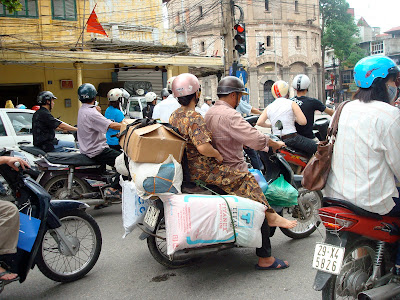Sudhir Gota
“Bike is the most democratic transport vehicle. Bike is the most daring, challenging as it gives its owner the tempting feeling of freedom, that is why one can say without any exaggeration, bike is a symbol of freedom” - Vladimir Putin
A recent comment by Russian Prime Minister Vladimir Putin on motorcycles as a means of democratic transport or as a symbol of freedom forced me to write a blog on motor cycles. Motorcycles are a unique mode of transport. Many people love to use it and many hate to see it. Based on my personal experience, I equate bikes with guns. It allows many to earn livelihood, reach hospitals and schools. But a single mistake can lead to several deaths!!
Motorized two wheelers have exploded in numbers in the last two decades. In 2005, Asian countries accounted for 80% of the total world’s motorcycle fleet of 290 million units and 90% of world motorcycle sales. China accounts for 50%, with around 17 million units produced per year while Indonesia and India with around 5 million units per year and Vietnam with 2 million units per year. The projections by experts suggest that the numbers would multiply in future as the technological solutions would increase the number of models while bringing the cost down. Increasing travel distances in our cities with availability of cheap loans is making it easier for two wheelers to prosper….
Also, increasing number of two wheelers has resulted in formulation of contradictory policies. Some cities have banned the use of two wheelers while some are promoting it with facilitating measures such as free parking, availability of loans etc. While the policy makers are still confused, the numbers are spiraling out of control. Increasing number of two wheelers are not only choking the streets but also magnifying the externalities. Sometimes riding motorcycles can be as dangerous as playing with guns. The latest WHO report which analyzed the causes of accidents and policy measures suggested that:
“Our roads are particularly unsafe for pedestrians, cyclists and motorcyclists who, without the protective shell of a car around them, are more vulnerable. These road users need to be given increased attention. Measures such as building sidewalks, raised crossings and separate lanes for two wheelers; reducing drink-driving and excessive speed; increasing the use of helmets and improving trauma care are some of the interventions that could save hundreds of thousands of lives every year. While progress has been made towards protecting people in cars, the needs of these vulnerable groups of road users are not being met.”
Many Asian countries have initiated measures such as mandating the use of helmets to reduce the fatalities. Globally only 40% of countries have a motorcycle helmet law that covers both riders and passengers, and mandates that helmets should meet a specific national or international standard. Use of helmets can save life of motorbike users as they can reduce the risk of head injury by 69% and death by 42%. Many Asian countries have initiated the mandatory use of helmets but implementation has been passive. Some of the two wheeler measures initiated by Asian countries:
1. Mandatory motorcycle helmet legislation
2. Traffic calming measures
3. Two- three-wheeler ban, 50-50 scheme etc.
4. Electronic enforcement
5. Road safety education (in primary schools)
6. Separation of traffic
7. Visibility enhancement
8. Limiting the engine capacity
9. Speed restriction
10. Organizing motorcycle clinics
The following table indicates the status of helmet laws and its implementation.
% of 2-3 wheelers in total road fatality | Helmet Law | Wearing rate | |
Thailand | 70% | Yes | 27% |
Philippines | - | NA | 34% |
Malaysia | 58% | Yes | 70% |
Indonesia | 61% | Yes | 93% |
India | 27% | Yes | - |
China | 28% | Yes | 16% |
VietNam | 60% | Yes | 85% |
Bangladesh | 8% | Yes | - |
Brunei Darassalam | 11% | Yes | 98% |
Singapore | 48% | Yes | 56% |
Srilanka | - | Yes | - |
Pakistan | 32% | Yes | - |
Nepal | 33% | Yes | - |
Combodia | 63% | Yes | 21% |
Republic of Korea | 21% | Yes | 85% |
Japan | 18% | Yes | - |
So what are the solutions for two wheelers in Asia? Is it symbol of freedom or congestion and other externalities? What do you think?

